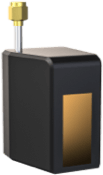Bringing imaging to where stroke occurs will save lives
Stroke is a global societal & health economic burden
Effective treatments available
They are time sensitive and require urgent brain imaging first
What clinicians need to know…
The ability to distinguish stroke type, size, severity and location, in a timely manner, is crucial to enable successful stroke treatment. Ischaemic stroke patients can benefit from clot dissolving drugs and clot retrieval. The EMVision technology opens the door for the earlier diagnosis and better bedside management of stroke patients.

Clot
Ischaemic
Bleed
Haemorrhagicemu™ Brain Scanner
Detect clinically significant changes, at the bedside, when time matters.
First Responder Brain Scanner
Ultra light weight device embedded in standard road and air ambulances to deliver pre-hospital stroke diagnosis and care to patients regardless of location.
This is an artistic concept of a proposed first responder device which is subject to prototype development and clinical testing.
The emu™ Brain Scanner is under development and its potential clinical utility is also subject to successful clinical testing and validation.
Disclaimer: Neither the emu™ or first responder devices are available for sale or clinical use. The devices’ safety, effectiveness and compliance
with regulatory requirements have not yet been evaluated by any regulatory authority.
Bringing neurodiagnostics to the patient, wherever they are

Portable
Easily manoeuvred, easily stored, just like a cart UltrasoundSafe
No ionizing radiation, no ferromagnetism, no special infrastructure or shielding requirementsBedside operation
Perform scans at the bedside, without needing to move equipment or transport the patientFast
Scans and neurodiagnostic output obtained in just a few minutesEasy to operate
One headset for all head sizes, simple pre-set positioning, push to scanTechnology process
Antennas
Array of proprietary antennas send pulses of low-power electromagnetic waves into the head.Headset
Waves penetrate tissue in a non-ionizing and harmless manner and are scattered based on the dielectric properties of tissue. Sensors in the helmet detect these complex interactions. The reflections are not dissimilar to those of the sound waves in ultrasound, but because the EM waves are of much higher frequency, they have more complex interactions. Anatomical dielectric properties are mapped.Point-of-care Neuroimaging
A powerful fusion of physics and data science-based techniques generate an image of the patient's brain, with artificial intelligence powered decision support.



EMVision probabilistic imaging case studies
- Non-ionizing radiation using ultra-high frequency radio waves (500-2000MHz)
- Scan power below standard safety concern levels and <10% of a typical cell phone
- Dielectric property contrast (conductivity and permittivity) cause scan signals to reflect and phase shift
- Stroke type classification enabled by dielectric contrast between haemorrhage, ischaemia and healthy tissue
- Neurodiagnostic output provided via onboard display
To learn more about the EMVision technology visit Peer-Reviewed Publications
Partners & Collaborators
Commonwealth CRC- P Grant Program Collaborators




Clinical Research

Product Collaboration

Clinical Development & Validation, Non dilutive funding

Inception Member

Technology collaboration

Research collaboration

Partner

Technology collaboration

Papers
-

29 October 2021
Case Report: Preliminary Images From an Electromagnetic Portable Brain Scanner for Diagnosis and Monitoring of Acute Stroke
Electromagnetic imaging is an emerging technology which promises to provide a mobile, and rapid neurodiagnostics modality for pre-hospital and bedside evaluation of stroke patients based on the dielectric properties of the tissue. It is now possible due to technological advancements in materials, antennae design and manufacture, rapid portable computing power and network analyses and development of processing algorithms for image reconstruction.Read more -

03 February 2022
Electromagnetic Portable Brain Imaging For Stroke
Electromagnetic imaging (EMI) is an emerging technology that transmits low energy electromagnetic waves from a ring of transceivers around the head, modified as they pass through abnormal tissue, providing unique signatures for brain pathology.Read more -

10 October 2023
EMVision Gen 1 Brain Scanner Study on Acute Stroke Participants
The EMVision Gen 1 brain scanner has further advanced its AI algorithms in the assessment of healthy participants, acute stroke and mimics.Read more